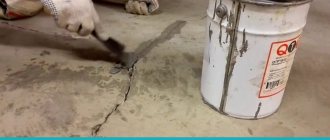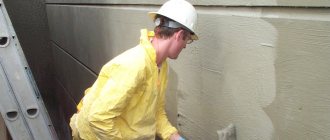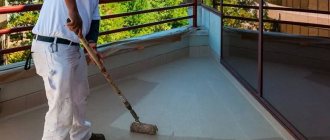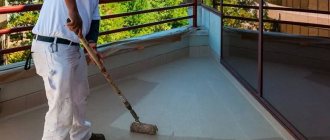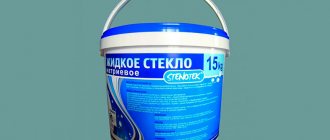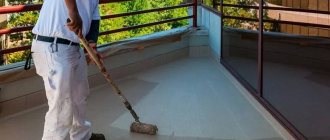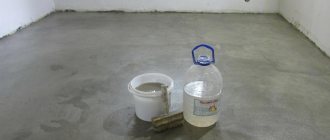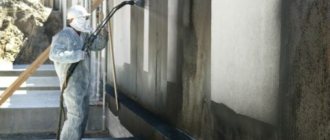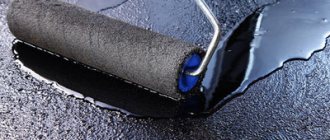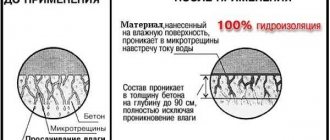SHARE ON SOCIAL NETWORKS
FacebookTwitterOkGoogle+PinterestVk
The list of modern materials that create a water-repellent layer is very wide. Among them, liquid glass rightfully occupies a place of honor. It is used for waterproofing on various objects. The unique properties of the product create protection from moisture not only on the floor, foundation, but also on car headlights, as well as in structures that have direct contact with water, in particular in swimming pools or wells. This article will talk about this.
Liquid glass is rightfully considered one of the best means for waterproofing.
Features, characteristics and composition of liquid glass
A popular product in construction, everyday life and creativity, called liquid glass, is a viscous, homogeneous substance. According to the chemical formula, it is an aqueous solution of sodium silicate or potassium silicate. The product contains microcrystals, which, after application, are perfectly absorbed and penetrate into the middle of the porous material, where they increase in size. When hardened, they create excellent waterproofing and make the surface airtight.
Liquid glass is an aqueous solution of potassium or sodium silicate
Due to its high penetrating ability, the material is also called soluble glass. It consists of molten quartz sand or soda, potassium or sodium silicate. The technological process of creating the product involves burning, crushing and thoroughly mixing its components. The versatility of liquid glass is due to its characteristics, including:
- water-repellent properties, that is, water-repellent ability;
- antiseptic effect that prevents the formation of bacteria, fungi and mold;
- antistatic – after coating with the product, the surfaces are not electrified and are less covered with dust;
- high degree of hardening, which helps create additional strength of the material;
- protection from alkalis and acids;
- fire resistance.
Advantages and disadvantages, areas of application, features of liquid glass processing
The versatility of the product suggests its wide use in various areas of production. Most often used in construction. Processing with liquid glass is carried out in cases where it is necessary to carry out the following types of work:
Liquid glass is excellent for waterproofing wood
- foundation waterproofing;
- creating a waterproof layer on walls, ceilings and floors in underground rooms;
- waterproofing of swimming pools and wells;
- addition to concrete to enhance water-repellent qualities and strength characteristics;
- dust removal of concrete floor surfaces;
- waterproofing wood;
- creation of bactericidal grout;
- quick gluing of different materials;
- use as a quick-drying substance;
- creation of fireproof coating;
- protection of tree trunks after cutting;
- use as a sealant in plumbing work;
- cleaning surfaces and utensils;
- decorating walls and creating self-leveling floors.
Helpful advice! A wide range of positive qualities, as well as the environmental friendliness and harmlessness of liquid glass, suggest its use not only in construction, but also in everyday life.
One of the ways to protect the foundation of a house from moisture is waterproofing with liquid glass - reviews from both experienced craftsmen and novice builders indicate a high degree of waterproofness of the film that covers the surface. Additional benefits are provided by other advantages of the material:
Soluble glass creates a waterproof layer on the treated surface
- high degree of adhesion;
- low consumption of funds;
- affordable price compared to other sealants;
- at least a five-year service life of the waterproofing layer;
- Possibility of use in conditions of high humidity.
The main disadvantages of waterproofing with liquid glass
While listing the advantages of the product, it is necessary to mention the disadvantages that this universal product has:
- Limited in combination with other materials, since this composition can only be applied to concrete surfaces and wood products. Liquid glass cannot be used on brick surfaces, as it will contribute to its destruction.
- Impossibility of use in its pure form. Waterproofing is carried out with the addition of other materials, the absence of which will lead to the destruction of the protective layer.
- Mandatory compliance with the proportions of liquid glass in combination with other components of the solution. Otherwise, the waterproofing properties and strength characteristics of the mixture will be lost.
The silicate solution must be applied very quickly so that it does not have time to dry out.
In addition, this composition is characterized by the complexity of application technology. To carry out waterproofing, certain skills are required. The work cannot be slow, as the mixture dries very quickly. For the same reason, it is better to mix the solution in small quantities.
Thus, the material itself is truly a universal means used to impart water-repellent properties to various surfaces. The success of its application depends on strict adherence to the rules of work and the proportions of liquid glass for waterproofing.
Properties of silicate composition
Coating the base with liquid glass gives it a number of additional properties:
- Increase in hydrophobic indicators. This is especially true for structures that regularly come into contact with liquid. A coating with the addition of liquid glass is ideal for swimming pools, basement buildings with the possibility of penetration of atmospheric precipitation and similar structures.
- Accelerated hardening. When covering the base with a standard cement-sand mortar, it will take up to five days for it to completely harden. Adding liquid glass reduces this period to a day.
- Increased waterproofing. Silicate material has antiseptic properties. Its use does not allow fungi and bacteria to multiply in the coating area. This is why surfaces treated with silicate glass are protected from mold.
- Increased heat resistance. Resistance to elevated temperatures for ordinary cement mortar is determined by 200 degrees. This means that if this indicator is exceeded, the base is deformed. The presence of sodium silicate in the solution increases the heat resistance. In this version, the coating can withstand temperatures above 1500 degrees. The use of such a mixture is in demand in the construction of stoves and fireplaces.
How to use liquid glass for waterproofing: methods of application
There are different ways to use silicate solution to give objects water-repellent properties. You need to familiarize yourself with them before using liquid glass for waterproofing in order to choose the most effective and appropriate technology in a particular case. Main methods of using the product:
- method of coating;
- penetration technique;
- adding material to concrete.
Most often, liquid glass is applied by coating or added to concrete.
The coating method helps to create the most effective surface protection; in particular, it is used when waterproofing the foundation as a preliminary layer, which is applied under roll insulation. For this purpose, this product (in its pure form) is applied to the concrete surface in two layers. After the liquid glass has completely dried, the main stage of insulation work is performed.
Helpful advice! Applying a coating layer to a concrete surface not only provides additional waterproofing, but also protects it from the appearance and development of harmful organisms, fungi and mold.
The penetrating technique is indispensable when the surface to be treated is difficult to reach. In this case, do not use pure liquid glass, but mix it with water in a 1:1 ratio and add another part of the dry building mixture. The solution is thoroughly mixed and applied immediately, as it dries very quickly. It is recommended to prepare a small amount of the mixture.
The coating method allows you to create high-quality surface protection
It is important to thoroughly clean the surface to be treated before applying the solution. In this case, the adhesion of materials will occur faster and will be more reliable. The mixture is applied using a spatula and the surface is covered with a wet cloth, which prevents cracking of the coating.
Reasons for moisture penetration in the cellar
1. The first, external waterproofing, was done incorrectly or its integrity was compromised. If there is a high level of water in the ground or a large amount of precipitation, a drainage system must be installed.
2. Changes in the occurrence of groundwater levels.
This happens due to natural processes. Another reason is due to the fact that structures were erected nearby that disrupted the previously existing balance of circulation. For example, a neighbor built a swimming pool and installed a drainage system that did not comply with the rules.
3. Shrinkage of the building, which leads to the formation of cracks and damage to the external insulation.
Making protection in an already built house is a complex and time-consuming process. The optimal solution is to use impregnation with liquid glass, rubber, or penetrating mixtures.
Advantages of waterproofing material
Brick, plasters, and concrete of various brands are a durable but porous composition.
With constant moisture pressure, a capillary suction effect occurs. Water penetrates them from the inside, rises to the top and gradually the wall becomes wet. Liquid glass is intended specifically for these types of surfaces; it is also used for wood, but a different application method is used.
Liquid glass is silicates (silica material) based on aqueous-alkaline solutions. There are two types: potassium and sodium. In the process, they fill micropores and crystallize, thereby creating an insurmountable barrier in the form of a film.
Advantages:
- The application process is simple, so you can easily carry out the insulation yourself. In concrete-cement structures, which in the vast majority of cases are used to make cellars, basements and basement floors, metal is used as a reinforcing base. The composition protects against corrosion. Acts as an antiseptic, preventing the formation of mold and mildew. The glass film is resistant to ultraviolet radiation and chemically aggressive environments. The material is highly reliable in terms of water penetration into the room. Used as protection for the decorative layer.
The disadvantages are that it is difficult to apply paint and finishes on top as it reduces surface adhesion. When applied to a damp base, waterproofing glass will not be absorbed, which is why the room must be thoroughly dried naturally or using heat guns before treatment.
You cannot dilute the composition in larger proportions than indicated in the instructions, even if it thickens.
Use in small batches as it hardens quickly. If you apply a thick layer, cracks may appear on it. Brick, plaster, and concrete should be coated in an amount that the surface can absorb.
Application of liquid glass for concrete waterproofing
Adding silicate solutions to concrete in order to increase its water-repellent properties is the most popular way to use liquid glass in construction. This method allows you to create a monolithic foundation and provide reliable waterproofing. These two factors perfectly explain why liquid glass is added to concrete. The procedure for preparing the mixture is simple. You can do this yourself.
The main thing in this process is consistency in adding components and maintaining the proportions of liquid glass and cement for waterproofing. To prevent cracking and destruction of concrete, it is important to consider the conditions in which the finished mortar will be used. To do this, you must follow these rules:
When using liquid glass with concrete, you must strictly follow the instructions
- Soluble glass is not added to the finished cement mortar. First, prepare the dry mixture, then gradually dilute it with a stream of liquid glass mixed with water, thoroughly mixing the solution.
- When adding silicate mortar to cement, it is important to strictly follow the instructions, which recommend strict adherence to the proportions of liquid glass in concrete. For waterproofing, this figure is only 3%, although in other cases it can reach 25% (of the total mass).
- When adding a sodium silicate mixture, the concrete solution quickly hardens. The work is simplified by adding water or making minimal portions.
- It is not recommended to prepare the solution in a concrete mixer, as it will begin to harden even during the mixing process.
Liquid glass for waterproofing concrete: ratio of materials
There are a number of subtleties in mixing cement-sand mortar with liquid glass for waterproofing. The proportions of concrete and silicate agent are generally 10:1. In rare cases, a different ratio of materials may be used.
As a rule, to prepare the solution, take 10 parts of concrete and 1 part of soluble glass
Attention! Under no circumstances should water be added to the finished mixture of concrete and liquid glass after the solution has been mixed.
The process and duration of its hardening depend on how much glue is added to the composition:
- if the solution contains 2% liquid glass, then the setting process will begin in approximately 45 minutes, and complete hardening will occur within a day;
- adding 5% of the product to the cement-sand mixture will entail an accelerated hardening process, which will begin in half an hour, and the final result will be noticeable after 16 hours;
- 8% soluble glass in the solution will set in a quarter of an hour, and the concrete will dry completely after 7 hours;
- The setting process with a proportion of 10% will occur within 5 minutes, and complete hardening will occur in just 4 hours.
When deciding whether it is possible to add liquid glass to concrete, it is important to take into account the type of cement. In this case, the M300 and M400 brands are applicable. To achieve a waterproof effect, the amount of glue is increased, but its maximum value should not exceed 25%. To prepare the solution, it is best to use a construction mixer, adhering to the following principles:
The solution must be mixed thoroughly; for this it is better to use a construction mixer
- You need to use clean drinking water, without impurities and salts, the maximum amount per batch is 10 liters;
- add liquid glass to the water and mix;
- the liquid is poured into a larger container;
- gradually add sand-cement dry mixture to the water-silicate solution;
- the solution is stirred until a homogeneous mass is obtained.
Preparation of silicate solution - tools and consumables
Experts advise using mixtures that are added to liquid glass. These mixtures serve the purpose of hardening when exposed to air and providing high strength. These mixtures are expensive. Most often, repairmen buy the necessary ingredients to prepare such mixtures with their own hands. In order to do this you will need the necessary tools.
The tools you need to have are a bucket that will be used for work needs. You will also need a drill to mix the solution, so it should have a screw-type attachment. A brush may also be required.
You will also need cement, sand, which must be finely sifted, and a source of water, such as a well. Also, as far as we know, the solution hardens very quickly and firmly, so it is necessary to have special clothing.
To obtain the desired solution, you need to mix water and liquid glass. The proportions of water and liquid glass depend on what type of work the solution will be used for. It is recommended to use cold water during the mixing process as this will make it easier to control the quantity.
The feasibility of waterproofing with liquid glass at various sites
The use of liquid glass with cement for waterproofing is popular in various cases, which is primarily due to the reliability of waterproof protection, the affordable price of materials and a number of other factors that allow the product to be used in various fields:
Related article:
Liquid glass for concrete: the versatility of silicate mixture
Composition of the solution, scope of application, rules of use. Drawing up proportions. Cost of the mixture and customer reviews.
- coating concrete with liquid glass on the street and in the middle of the room makes it practically invulnerable to moisture and suggests its use under water;
- waterproofing a pool with liquid glass is a less troublesome process compared to using other materials for this purpose, allowing you to get excellent results at low cost;
- waterproofing the basement using sodium silicate will protect the underground room from the penetration of groundwater and melt water, and will also save it from the formation of mold and fungi;
- waterproofing the foundation with liquid glass will protect the entire building from moisture entering the middle of the room, which is especially important in places where groundwater is located close to the surface of the earth;
Silicate solution is ideal for waterproofing horizontal surfaces
- applying a water-repellent layer of liquid glass to the walls of premises is a less popular method of waterproofing, relevant mainly for underground premises;
- liquid glass used for waterproofing a well helps to create reliable protection against loss of water from the tank, and the effectiveness increases if a double layer is applied;
- Waterproofing a floor with liquid glass is most effective, as it penetrates into the smallest pores and cracks of any surface, which is due to the chemical properties of the material.
Helpful advice! In addition to providing reliable waterproofing of the floor, liquid glass acts as an antiseptic and can be used as an adhesive for installing any rolled or block flooring.
Varieties and properties
Liquid glass is an aqueous solution of potassium, sodium or lithium silicate with the addition of modifiers. The scope of application of the product depends on its main substance:
- sodium is used for the production of construction adhesives and waterproofing solutions;
- potassium is used for the preparation of acid-resistant concrete and cement mortars;
- lithium is suitable for strengthening treatment of concrete floor bases followed by polishing.
The silicate compound looks like a thick yellow or gray liquid, it is odorless and does not emit toxic substances. The solvent is water. Treating concrete with liquid glass makes it possible to improve its resistance to external influences.
Do-it-yourself waterproofing with liquid glass: general recommendations
Before applying a sodium silicate solution or carrying out cement waterproofing with liquid glass, any surface (or object) is thoroughly cleaned of dust and dirt, followed by a standard set of actions:
Soluble glass can be applied with brushes, rollers or a spatula
- Coating the surface with the mixture using a brush, roller or spatula (if cement is added to the solution to the liquid glass).
- Apply (if necessary) a second coat at half-hour intervals.
- Preparing a solution for the protective layer if the waterproofing involves the use of concrete. The components are quickly mixed and applied, preventing the mixture from hardening.
- Reusing or storing cement-sand mortar with the addition of liquid glue is unacceptable, since the qualities of the material are quickly lost.
Before using a silicate solution, it is necessary to examine it for the presence of impurities and additives. The composition must be homogeneous, without foreign inclusions or lumps. The product can be stored in its pure form for a relatively long time in a tightly closed container. The temperature for using liquid glass ranges from 5 to 40 °C. Storage is permissible even at temperatures as low as -30 °C, since frost resistance is one of the many positive qualities of the material.
The recommendations given are of a general nature; below we will consider specific cases of using liquid glass for waterproofing. For example, to use the product on a foundation, its surface is cleaned with sandpaper, the solution is applied with a roller in 2, and if desired, in 3 layers with an interval of 30 minutes.
The use of liquid glass for waterproofing swimming pools
A swimming pool is considered a rather complex construction project, which must cope with significant loads, in particular, withstand a large thickness of water, preventing it from flowing out of the bowl. Without waterproofing measures, water will have the opposite effect and lead to destruction of the surface.
Waterproofing of swimming pools must be carried out not only inside the bowl, but also outside
Waterproofing a pool with liquid glass is carried out both inside and outside the bowl. Double protection will help avoid a number of negative consequences: inside the structure it will prevent destruction and leakage, and on the outside it will protect the object from the unwanted effects of groundwater. If waterproofing measures are neglected, then under the influence of groundwater that penetrates the pores of the concrete, the reinforcement will be destroyed, which will inevitably lead to deformation of the entire structure. It is liquid glass, forming a film that repels water, that can prevent the appearance of cracks in the walls of the pool.
To waterproof a pool with liquid glass, different technologies for applying the material are used: with a brush, roller, or spraying. It is advisable to cover the outside surface with 3-4 layers. Inside, a two-layer application of the product is sufficient. In this type of work, it is important to adhere to the following rules:
- Clear the surface of any debris.
- Make the top of the structure as smooth as possible by sanding. If necessary, re-plaster and grout.
- Degrease the surface.
- The presence of tubercles no higher than 1 mm is acceptable.
Helpful advice! In places with high humidity, such as a swimming pool or basement, the mixture is taken in a 1:10 ratio of liquid glass to concrete.
It is convenient to waterproof a pool with liquid glass using the spray method.
If you neglect such basic rules, then after hardening the coating will peel off and crack. In this case, the waterproofing will have to be carried out completely anew with the dismantling of the previous layer.
Do-it-yourself basement waterproofing with liquid glass: stages of work
Coating basements and attics with liquid glass is similar to the process of waterproofing concrete structures. Due to the high degree of protection, it is permissible to apply the material both outside and inside the building. The process itself is quite quick, the service life is quite long, equal to the service life of the premises itself.
The property of liquid glass to penetrate into the smallest pores and cracks guarantees reliable protection against moisture. Despite the water-repellent ability, the hardened layer does not lose vapor permeability. To waterproof the basement with liquid glass indoors, use cement mortar. To prepare 10 liters of the mixture, it is enough to take 1 liter of silicate composition.
To waterproof the basement from the inside with liquid glass, the mixture is prepared according to a different recipe. To do this, take cement, sand and soluble glass in a ratio of 1.5:1.5:4. In this case, the amount of water should not exceed 25% of the total weight of the solution. Work on waterproofing a cellar with liquid glass is carried out in the following sequence:
To waterproof a basement, you need to mix liquid glass, sand and cement in a ratio of 4:1.5:1.5
- Surface preparation, which includes cleaning from dirt, dust and debris.
- Processing the workplace with a sandblasting device to expose the pores of the concrete.
- Wiping the surface with an aqueous solution of hydrogen chloride in a ratio of 1:10.
- To be more confident, you can treat it with an antiseptic, although liquid glass itself has antibacterial properties.
- Grooving holes, cracks and joints 25 mm deep and 20 mm wide.
- Creation of a sealed layer on utility lines.
- Wetting the concrete surface by irrigation.
- Preparation of waterproofing solution in accordance with the manufacturer's recommendations.
- Prompt application of the mixture with a spatula or brush.
Area of application of the material
The composition is used for various types of construction work:
- Production of concrete blocks with special technical characteristics: fire resistance, frost resistance, acid resistance.
- Production of plaster with hydrophobic properties.
- Waterproofing when laying the foundation.
- Waterproofing of walls of basements and basements.
- Construction of swimming pools and wells.
- Construction of fireplaces and stoves.
Waterproofing the foundations of buildings is important in the presence of groundwater. However, even in a more favorable area, additional protection from moisture is necessary, which can destroy the foundation Source martand.ru
Waterproofing of plinth and foundation with liquid glass: coating and penetrating technologies
Builders use two main technologies for waterproofing the foundation and plinth with liquid glass. The coating method of hydraulic protection of the foundation is necessary when the use of bitumen solutions is undesirable, for example, in the case of using roll materials made of polymers that are incompatible with petroleum products. The water-protective function of sodium silicate is manifested in its penetration into the pores of the material. Moreover, the protective layer itself is only a few millimeters thick.
Helpful advice! By carrying out the work step by step, you can obtain reliable insulation that will protect the structure not only from moisture, but also from fire.
A solution with liquid glass for waterproofing the foundation and plinth is prepared in small portions
The process itself includes the following steps:
- cleaning and degreasing the surface;
- light brushing to open capillaries on the concrete surface;
- use of the product. To coat concrete, liquid glass is applied using a wide brush;
- after the first layer has dried, perform the second;
- After the solution has completely hardened, roll waterproofing is produced.
Penetrating technology is used mainly for waterproofing joints and seams in block-type plinths. The solution is a mixture of cement diluted with water with the addition of liquid glass, which should not be more than 5% of the total volume. The mixture is prepared in small portions; before this, preparatory work is carried out, including removing seams, joints and other damage, as well as cleaning them. The cracks are grooved, giving them a U-shape.
Soluble glass with concrete is excellent for waterproofing joints and seams
The solution is prepared in this way: liquid glass is diluted with water in a ratio of 1:10 or 1:15. The resulting mixture is poured into dry cement to obtain a thick and plastic mass. Repeated stirring of the solution is unacceptable, since the process of crystal formation will be disrupted, which will lead to loss of adhesive properties.
The use of liquid glass for waterproofing wells
In order to retain water in the well, it is waterproofed. Otherwise, the contents will simply seep through the walls into the soil, as a result of which the tank will lose its purpose. The main thing is to ensure reliable insulation between the rings of the well and to saturate the concrete walls themselves.
Before starting work, you need to make sure that the well is securely fixed, otherwise waterproofing will not save you from seepage. To avoid such undesirable consequences, additional fastening is carried out using durable metal brackets. After the strengthening work is completed, the seams between the rings are tightened. To do this, use a rope made of flax, jute or hemp, coat it with liquid glass and tighten the inter-ring seams.
First, the well is covered with clean liquid glass, and after drying, a concrete solution is applied
After this, general waterproofing of the wells with liquid glass is carried out in two stages. The first involves coating the walls with a clean product, the second involves applying a concrete solution consisting of a cement-sand mixture and sodium silicate in equal parts. It is advisable to carry out work on creating an insulating layer during the construction stages, applying the product to a dry surface until the tank is filled with water. If partial filling does occur, it is recommended to cover the walls not covered with water as much as possible.
Features of waterproofing liquid glass in rooms with high humidity
The method of applying a moisture-protective layer using sodium silicate, as one of the most budget-friendly options, is widely used in various rooms with high humidity. This method is quite often used for priming indoor pools, saunas, showers and bathrooms.
Helpful advice! The maximum content of liquid glass in the cement mortar should be 25%; exceeding this figure will lead to rapid destruction of the concrete.
Waterproofing technology for outdoor pools is not characterized by distinctive properties. The main feature is the use of special solutions made for interior work. For example, the soil solution for swimming pools has a special formula; applying it in a thicker layer ensures a long service life of the water tank.
Objects exposed to high humidity are best treated in two stages
For waterproofing floors, pallets and other surfaces in rooms with high humidity, liquid glass is used in its pure form or as impregnations and additives. Thanks to good penetration into the pores of concrete and wood, the material provides reliable protection against destruction and corrosion.
Liquid glass for bathroom waterproofing was previously used quite widely, due to the low cost of the material and ease of application. The main disadvantage is its poor wear resistance due to constant exposure to moisture. Currently, manufacturers have come up with many alternatives to the classic material. At the same time, sodium silicate is an indispensable tool for waterproofing sewer pipes, filling joints in concrete floors of bathrooms and homemade trays in showers.
What can be done or waterproofing options
Cellar waterproofing is a complex of drainage works. They can be divided into two blocks:
waterproofing basement walls outside the house. It is advisable to carry out these works during the construction stage.
Then any type of moisture control, be it bitumen mastic, plastering with water-repellent solutions, laying roofing felt or other rolled or sheet material, will act as a shield. Streams of water will press this shield against the wall and, resting against it, roll down; External waterproofing of basement walls. isolate the walls and floor of the cellar from the inside from any moisture.
Simple cement plaster will not give the desired result. Masses of underground water will try to tear it away from the wall. This requires special mixtures and techniques. Internal waterproofing of the basement can be done at any stage.
Important! Waterproofing is only effective when, as a result of work, an additional protective layer appears on all surfaces of the cellar. The solidity of the shell made of polymer materials creates conditions for a normal climate in the cellar.
The cost of liquid glass for waterproofing: recommendations for purchasing the material
The affordable price of liquid glass for waterproofing is the main advantage of this universal product. Other synthetic impregnations and insulators, including the latest generation, are several times more expensive. The price of the material depends on components such as density, modulus and volume of purchased goods. It is recommended to buy the solution in special containers, and not by weight. Tightly closing production containers prevent premature drying of the product. You can purchase the solution at any construction supermarket or hardware store.
The average cost of soluble glass is $2 per 10 liters
The cost of waterproofing material depends in some way on the choice of the manufacturer. The range is quite wide, but there is practically no difference in the composition of the product, since it is manufactured in accordance with GOST 13078-81. Therefore, the choice of brand is up to the buyer. The average price of liquid glass for concrete waterproofing per 10 liters is about $2. Thus, the multifunctional material is low in cost.
The purchase price also depends on the volumes of the product purchased. As with most building materials, buying in bulk will cost much less. Special high-density liquid glass, which is used for waterproofing swimming pools, has a more significant cost.
Helpful advice! Carrying out the work yourself will help you save on waterproofing, but this will require some skill in applying the solution, which sets very quickly.
Sources of water and moisture penetration
Where can water get into the basement? There can be many sources and reasons.
Water penetrates through cracks, microcracks and pores. For example, reinforced concrete allows moisture to pass through micropores that remain when it sets. Water came out through these pores as the concrete gained strength.
Microcracks can also form in a brick wall, or rather in masonry mortar. Settlement of the building or depressions from fastening materials also compromise the integrity of the basement walls.
And if the walls in the cellar have a layer of lime plaster, then the lime itself attracts and retains moisture. There is no need to talk about groundwater levels or seasonal floods at all. This always posed a threat to the “golden” reserves in the cellar and had a detrimental effect on shelving and electrical wiring.
Such a small crack is enough to ruin the entire cellar.
How to work with liquid glass for waterproofing: general application recommendations
In various types of waterproofing work, one of the important conditions is surface preparation. The reliability of the coating depends on thorough cleaning of the workplace from dirt, dust and grease. Otherwise, the adhesive properties of liquid glass and the absorbency of the base will be reduced.
The mixture with liquid glass must be applied to a clean, prepared surface.
Despite the rapid hardening of the mixture, it is recommended to allow approximately 24 hours for the solution to dry completely. When layer coating, be sure to allow time for setting when applying each layer. The product in its pure form or in combination with water is applied like paint, using a wide brush or roller. When working with cement mortar, use a plaster spatula.
The choice between the type of liquid glass, which can be sodium or potassium, depends on the range of intended work. Potassium silicate is used to create and fill foundations because it has a more viscous material structure. For waterproofing work, the sodium version is more acceptable.
Sodium-based liquid glass is cheaper, but potassium silicate has higher waterproofing characteristics and can serve as an independent coating. On top of the sodium solution, you will need to apply another layer of waterproofing. This is, as a rule, a traditional pool finish with polypropylene, mosaic, PVC coating or ceramic tiles.
Surface preparation
If external waterproofing is for some reason impossible or postponed until a certain point, then you can limit yourself to waterproofing the basement or cellar from the inside. But only at first. If frequent precipitation and changing groundwater levels are very common in your area, then waterproofing work should be carried out only in conjunction with external drainage and ventilation.
It is better to start interior work in warm weather and dry weather. You need to carefully examine the walls and floor of the cellar.
Mark leak locations with chalk or marker. It is advisable to remove the old plaster completely. Otherwise, nothing and no one can guarantee the quality of work and the effectiveness of combating penetrating moisture.
You should also cut all seams to a depth of approximately 50 - 60 mm. If there are cracks or depressions from anchors in the surface of the walls, then they need to be expanded or drilled out.
Carefully examine and use a puncher, if necessary, to open the junction of the walls and floor. The penetration of groundwater begins in this place. If there are signs of mold or mildew, these areas should be thoroughly cleaned!
It is very important to thoroughly clean the walls before waterproofing.
Liquid glass for waterproofing: useful tips and safety rules
To use liquid glass more effectively, experienced builders have developed a number of useful tips that should not be neglected:
It is necessary to apply liquid glass with gloves and closed clothing so that the substance does not get on the skin
- liquid glass cannot be used for waterproofing brick surfaces, since the quickly hardening mixture can lead to destruction of the brick base;
- It is necessary to prepare and apply the composition in small portions, since liquid glass sets very quickly;
- in preparing a solution, important conditions are compliance with the proportions and consistency in mixing the components, otherwise this product will simply lose all its properties;
- Sodium-based liquid glass has higher adhesion and combines well with mineral materials, while potassium liquid glass can be used in highly acidic environments.
Thus, liquid glass is actually an irreplaceable and truly universal means for waterproofing. By using it in the correct proportions with other materials and using a minimum dosage, you can obtain high-quality and durable waterproofing. The solution can be used on various surfaces and objects. Simplicity and ease of use make it possible to do the work yourself.
Advantages and disadvantages
Impregnating concrete with liquid glass and adding silicates to the concrete mixture has a number of advantages:
- building structures receive protection from atmospheric and ground moisture;
- the material's resistance to acids increases;
- the strength, heat resistance and frost resistance of concrete increases;
- ensures the resistance of structures to the appearance and spread of fungus;
- the treated surface increases wear resistance;
- Due to the fluidity and viscosity of the composition, high adhesion, when applied, an even coating is formed, firmly adhered to the concrete base.
Compared to bitumen and polymer waterproofing materials, silicate compounds are inexpensive and economical in consumption. The coating is designed for 5 years of service, after which the treatment must be repeated.
The list of disadvantages includes:
- quick setting - the mixture should be prepared in small portions and used immediately;
- high fragility of the hardened film - the surface subject to mechanical stress must be additionally protected with roll waterproofing;
- treated concrete is less susceptible to drilling and cutting grooves;
- if the integrity of the film is damaged, the effectiveness of waterproofing decreases;
- silicate solutions cannot be used for processing brickwork or used in conjunction with solvents and organic resins;
- violation of the prescribed proportions of liquid glass in concrete worsens the performance of structures.
Characteristics
ZhS is a material of a viscous, viscous consistency, which dries quickly in air and forms a monolithic, durable, water-impervious base.
Liquid glass, sodium and potassium, have the following characteristics:
- Prevents water from penetrating through the surface treated with the solution.
- Protects wooden and concrete surfaces from the penetration of fungus and pathogens.
- Prevents the accumulation of static voltage.
- Protects the treated surface from fire.
- Protects the base impregnated with the solution from the effects of acidic compounds.
- Helps accelerate the drying process and strength gain of cement mortars.
Advantages and disadvantages
When working with RC in construction or during repairs, the following advantages are revealed:
- this material helps to quickly repair small cracks in concrete products and wood building structures;
- coating with liquid glass makes it possible to obtain a durable film that helps waterproof any surface;
- material consumption is low, while the cost of liquid glass is affordable for most categories of the population, so it can be used for work at home;
- if used correctly, the coating service life will be at least five years;
- Liquid glass for waterproofing can be used in places with unstable humidity levels.
There are also negative features of JS. The disadvantages include:
- this material is not used for processing brick buildings;
- ZhS cannot be the only material for obtaining reliable waterproofing; it is usually used together with other materials;
- for processing structures and products of reinforced concrete, it is advisable to have certain skills, since such solutions instantly dry and harden;
- To obtain a better coating and protect the base, it is necessary to apply a primer before the LC.
Methods of applying material
When working with liquid materials, it is necessary to use means of physical protection for the worker, for which they use protective suits and protective masks. Contact of the solution with the eyes can cause significant harm to health.
It is recommended to apply liquid glass with your own hands using a roller or brush. The final rise of the solution occurs within about half an hour, then the next layer is applied.
Repair mortars containing cement are applied with a spatula, but when performing work, one must not forget about the immediate setting of the mixture (usually within half an hour), so the volume of a single batch must be accurately calculated.
Waterproofing with liquid glass
Waterproofing mixtures using JS make it possible to treat any structures, including concrete and wood, in established areas with humidity exceeding the norm.
Foundation
To protect the foundation from destruction in a humid environment, it is necessary to apply liquid glass for concrete. The instructions for use indicate that for maximum protection this operation should be performed twice. After application, the layer must dry completely, then apply the next one. After the concrete base is impregnated with glass, the insulation is reinforced with other technical materials.
To eliminate cracks and mask the joining seams, prepare a repair composition in the following ratio: cement - 1 kg, water 750 ml, ZhS - 50 grams. To ensure better protection of the concrete base, it is recommended to use ZhS in the form of an additive in a volume of 5% of the total mass of the mixture.
swimming pool
To eliminate leaks in the bathtub of a structure, it is necessary to treat the surface of the concrete. The solution is evenly applied to the walls and floor of the structure. After one layer has dried, apply the next one. To reliably protect the structure, it is recommended to impregnate it three times.
From exposure to groundwater
Special concrete, which contains LC, can limit the flow of groundwater.
Basement
This important structure in the house and protecting it from leaks is the main condition for maintaining a favorable climate in the apartment and in the interior. Typically, owners are faced with the problem of cracks and poor waterproofing of joints. To get rid of the problem you will need:
- Clean cracks and seams from foreign objects and dust;
- Prepare a repair mixture in the following ratio: cement – 20 parts, liquid glass – 1 part. Maximum plasticity of the mixture should be achieved, for which its consistency is controlled by the volume of water;
- Cracks are sealed with a repair compound;
- Level the repair site by plastering it with the same mixture;
- The repair area is coated with water using a brush;
- After 24 hours, a layer of GS is applied.
When performing waterproofing work, it is necessary to remember the chemical reactions that occur with mixtures in which liquid iron is present. Due to the rapid hardening of the solution, in order to save material, it is recommended to prepare small volumes for work.
Kinds
There are several types of liquid glass. They are divided depending on the main substance used in the mixture.
Sodium
The formation based on sodium salts is characterized by a viscous structure, high strength and penetrating ability. It perfectly resists open fire and high temperatures, and the composition is also able to retain its shape even when the base on which it was applied is deformed.
Potassium
This material contains potassium salts. The structure of the mixture is loose, the composition has increased hygroscopicity, and forms a matte surface. Potassium compounds resist excessive heat and deformation well.
Lithium
It is used to provide the treated surface with protection from thermal effects. Produced in small batches. For some work, combined mixtures are used.
Ensuring safety precautions
The glue is non-toxic, non-flammable and non-explosive. The prepared mixtures are stored in a dry, cool place at a positive temperature of 5 to 40 degrees.
Safety precautions and precautions Source beton-house.com
Silicate glass is frost-resistant and can withstand temperatures down to minus 34 degrees. The material can withstand 5 freeze/thaw cycles without losing its consumer properties. Should not be placed near heating devices or operating equipment. Residues must be disposed of correctly - do not pour into water bodies, soil or sewers.
Pouring the flooring
In bathrooms, showers, bath rooms and indoor swimming pools, which are characterized by constant humidity and wet floors, flooring can be made using liquid glass. To fill the floor you need:
- if wooden floors are laid, then first make a concrete screed; pour silicate solution onto the dried surface in equal portions; level the adhesive layer with a wide spatula; carry out the final leveling of the 3-5 mm thick layer using a squeegee; after the silicate layer has dried, apply a finishing coat of varnish ( polyurethane or epoxy would be better).
It is worth considering that it is impossible to decorate a floor already covered with liquid glass. When pouring a concrete screed, the floor surface will have a corresponding “concrete” color and texture.
Decorating the floor must be done before applying a layer of liquid glass. Alternatively, you can paint the concrete. At the same time, it is recommended to add a small amount of silicate to paints and varnishes to improve their adhesion to concrete. After the paint has dried, you can fill the floor according to the above algorithm. By the way, taking into account the non-toxicity of the material, its heat and water resistance, it can be used to treat a steam room, which is most often made of wood and can be subjected to constant exposure to moist hot air without proper care deformation.
Where to order JS?
Searching and choosing a store or supplier of liquid glass directly depends on the required volumes for your goals and objectives.
In small quantities it can be found in construction markets, hypermarkets or on websites.
But if you need to purchase sodium liquid glass in large volumes of 1 ton or more according to individual characteristics, you must contact federal manufacturers, for example, the Promsteklocenter company. According to the information posted by this manufacturer, it produces and supplies silicate products throughout Russia and the CIS in any container and by any transport, and also owns its own laboratory, which guarantees high quality of the product.
What does it represent?
In classic concrete mixtures, the main components are:
- sand;
- cement;
- crushed stone
Adding liquid glass to the mortar will help increase the service life of the structure.
By adding water to the dry composition, it will be possible to obtain a durable building material for pouring a foundation, concrete floor, as well as erecting structures for various purposes. However, sometimes the physical and technical properties of such concrete are not enough for the structure to reliably perform its functions. To improve the technical characteristics of the solution, a special concrete additive based on liquid glass is used. The result is a reliable coating that is resistant to negative external factors, thanks to which the structure will last much longer than the stated period.
Penetrating waterproofing of walls
Once you have prepared the surfaces in the cellar, you can begin sealing seams and cracks. First, the surface should be cleaned of dust.
Then thoroughly wet all cracks and seams between blocks or bricks. Penetrating waterproofing is applied only to a damp surface. Well-wetted concrete from the inside of the basement allows chemically active elements that are added to the cement-sand mixture to pass through. A chemical reaction occurs, and the solution seems to sinter in the pores of the concrete, forming an insurmountable obstacle to groundwater and external moisture.
This mixture must be kneaded little by little, at the rate of 3 kg of dry mixture per m2. It needs to fill all the cracks you have prepared.
Moreover, you need to push it in very tightly, squeezing out the internal air as much as possible. There are two types of such mixtures, some fill cracks like plasticine, others are applied like whitewash with a paint brush. The direction of movement of the brush can be arbitrary.
A layer of 2 - 3 mm is able to protect a concrete wall and floor, and the crystals of active substances clog the concrete several tens of millimeters deep.
After treating the walls and floor with a penetrating composition, the entire internal surface of the cellar should be regularly moistened with water. This should be done within three days. For example, using a conventional sprayer.
Important! Penetrating mixtures should only be applied to a wet surface. Gaps and cracks in the wall and on the floor of the cellar are coated without gaps, creating a single layer.
Penetrating waterproofing of walls

